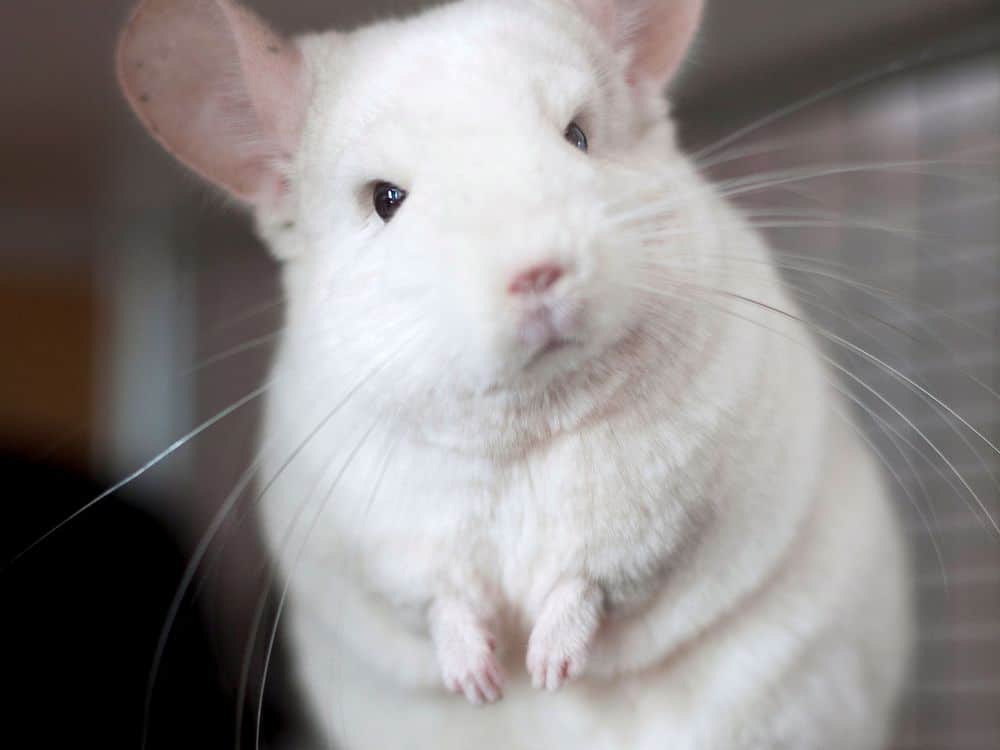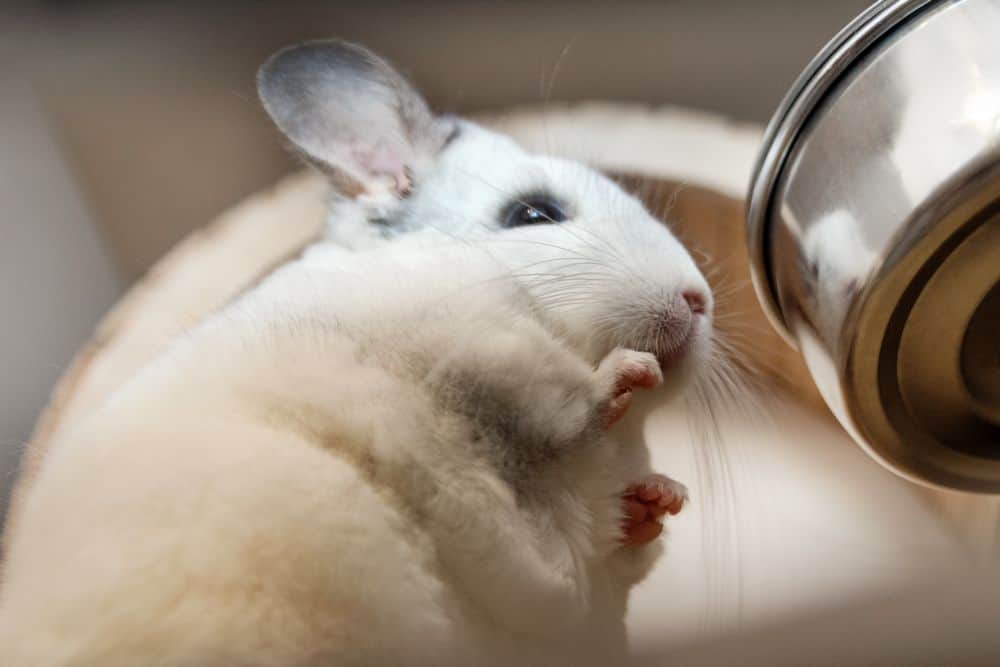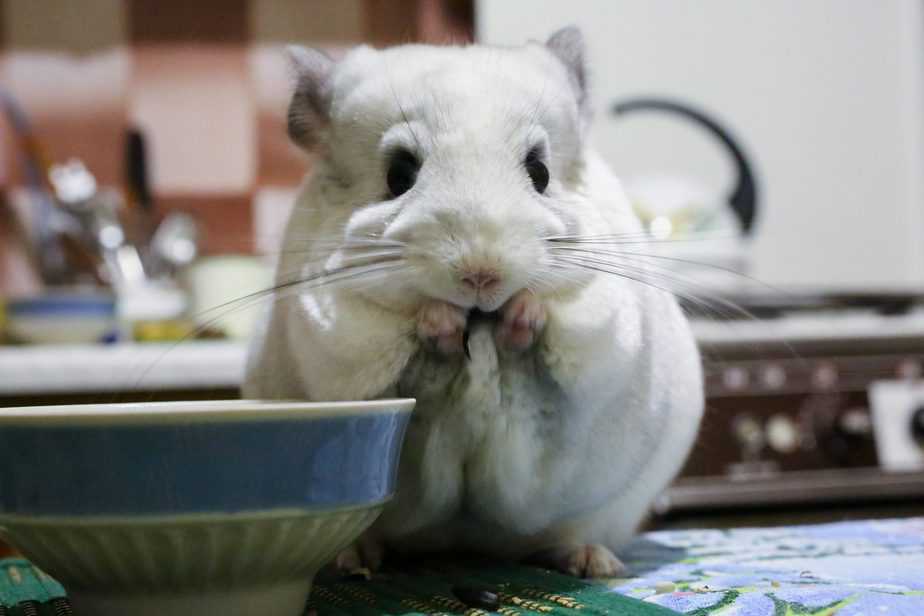
Of all the chinchilla colors, gray is by far the most common.
And the goldbar chinchilla is arguably the rarest.
So where does the white chinchilla fit it?
It is one of the more common colors, though not as common as gray.
That means you may have to wait a while before you can find one, if you have your heart set on a chinchilla that is white.
Is it worth it? Keep reading to find out. We’re going to cover everything you need to know about the white chinchilla.
Contents
White Chinchillas
If you are considering adopting a white chinchilla, there’s plenty to learn about these adorable creatures! They are known for their fluffy white fur, cute little ears, and playful personalities.
Characteristics

White chinchillas are known for several unique characteristics. They have big, black, sparkling eyes, and round, perky ears.
Their dense fur, like that of all chinchillas, is often described as extra-soft, extra-fluffy, and extra-pristine, which makes grooming a bit more of a challenge to pet owners. They are very social creatures and thrive with plenty of social interaction and playtime.
White chinchillas are quite active, curious, and love to play. As a result, they require ample space to move around, interact with other pets, and create their own space. They are also sociable and like to have company, so keeping two or more chinchillas is ideal, if you want to keep them happy and healthy.
However, white chinchillas can be quite shy, especially around new people. They require a bit of training to become more comfortable around humans. If you want a pet that needs a lot of love and attention, a white chinchilla might be the perfect choice for you!
White Chinchilla Price
The prices of white chinchillas vary depending on where you are buying them from. They can cost between $100 and $200. Certain white chinchillas, like the Royal Persian Angora, can cost more than that.
You can check your local pet stores, but it is advisable to search for reputable breeders or rescue centers instead.
Make sure you purchase from certified and reputable breeders to avoid any inbreeding or health issues. Chinchillas are popular pets, and you might have to wait a little before getting a white one.

White chinchillas are not particularly expensive, but maintenance costs can add up quickly. They require a diet of hay and specialized pellets, grooming in the form of dust baths, and a suitable living environment.
You should also figure on some vet visits. I would suggest taking these costs into consideration before getting a white chinchilla as your pet.
How To Care For Your White Chinchilla
White chinchillas have a specific dietary requirement that you meet by feeding it a diet of hay and commercial chinchilla pellets.
Their teeth grow continuously, which requires they have wood sticks to chew on regularly. Hay also helps them grind down their teeth.
You can give them treats every now and then such as rose hips, shredded wheat or goji berries. You should be prepared to feed them a strict diet that is suitable for their needs.
Housing for your white chinchilla should be spacious enough for its energetic personality and plenty of fun accessories to play with. Ideally, you want the cage placed in a quiet spot, away from direct sunlight.
The cage should also include amenities like chew toys, ramps, shelves, hiding spots, and exercise wheels to keep your pet engaged and entertained.
White chinchillas are sensitive to heat, so be sure to keep the cage in a temperature-controlled environment and away from direct sunlight. Also, regular cleaning of the cage is necessary to keep the pet’s environment clean and healthy. Clean out waste daily and do a weekly deep clean.
Given their thick fur, white chinchillas require frequent grooming. Luckily, your chinchilla can generally take care of the grooming on its own. Simply provide it with a dust bath 2 or 3 times per week and it will keep its fur nice and clean.
Do not wash your white chinchilla. You should avoid getting its fur wet at all. The thick fur takes forever to dry completely, which can lead to skin issues. It can also cause your pet to get hypothermia.
Regular vet checkups should help prevent and spot any health issues, though chinchillas are generally healthy if you provide good care, so you may not need to take it to the vet, except if something is wrong. Vet visits are stressful on your pet, so you want to avoid them if you can.
White Chinchilla Pros And Cons

White chinchillas make terrific pets. They provide companionship and affection. They are small and can fit into most apartment spaces and generally do not require much maintenance.
However, their high-energy nature means they need lots of playtime and socialization, which may be challenging for some owners. If you only have one chinchilla, you will need to give it an hour of supervised playtime outside the cage, at a minimum. They also require a controlled diet for optimal health.
White Mosaic Chinchilla
The term white mosaic chinchilla usually refers to a chinchilla that has gray coloring on a bas of white. However, it can actually be any color on top of white. It’s just that gray is the most common chinchilla color.
Pink White Chinchilla
A pink white chinchilla is a white chinchilla that also carries the beige gene. A a result, they have several characteristics of beige chinchillas, like the pink ears and red eyes. Most pink white chinchillas have mainly white fur, with some being completely white and others have some beige as well.
All White Chinchilla: Final Thoughts
The white chinchilla is not as common as the standard gray color, but it is not a rare color either. As such, the cost of a white chinchilla is not much higher than that of a gray one.
The biggest problem is getting a white chinchilla is availability. Depending on where you live, it may be easy to find one, or you may have to wait a while until you can locate one that is available.
Leave a Reply